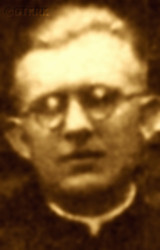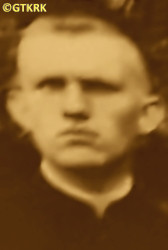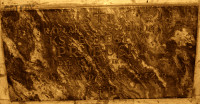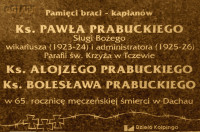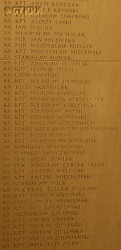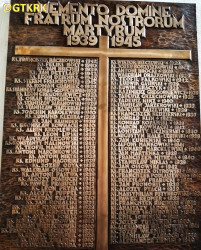Roman Catholic
St Sigismund parish
05-507 Słomczyn
85 Wiślana Str.
Konstancin deanery
Warsaw archdiocese, Poland
full list:
displayClick to display full list

searchClick to search full list by categories
wyświetlKliknij by wyświetlić pełną listę po polsku

szukajKliknij by przeszukać listę wg kategorii po polsku

Martyrology of the clergy — Poland
XX century (1914 – 1989)
personal data
surname
PRABUCKI
forename(s)
Boleslav Rock (pl. Bolesław Roch)
function
diocesan priest
creed
Latin (Roman Catholic) Church RCmore on
en.wikipedia.org
[access: 2014.09.21]
diocese / province
Culm (Chełmno) diocesemore on
pl.wikipedia.org
[access: 2012.11.23]
RC Military Ordinariate of Polandmore on
en.wikipedia.org
[access: 2014.12.20]
date and place
of death
12.08.1942

TA HartheimSchloss Hartheim „euthanasia” center
today: Alkoven, Eferding dist., Salzburg state, Austria
more on
en.wikipedia.org
[access: 2022.07.18]
alt. dates and places
of death
24.09.1942 (KL Dachau „death certificate” date)
details of death
According to some sources, from 01.06.1939 reserve chaplain of the Polish Army.
After German and Russian invasion of Poland in 09.1939 and start of the World War II, was to take part in the defensive campaign, and after Poland's defeat and the beginning of the German occupation, returned to Lubawa.
Arrested by members of the German genocidal organization Germ. Volksdeutscher Selbstschutz (Eng. Self‐Defense) on 02.11.1939.
Held in Lubawa, from where was taken to VSH Rypin custody in Rypin.
On 14.11.1939 imprisoned in the VSH Obory internment camp.
From there, on 22.02.1940, transported to Grudziądz and held in the VSH Graudenz transit camp.
Then, on 05.04.1940, transported to the KL Stutthof concentration camp.
On 09‐10.04.1940, with a large group of imprisoned priests, moved to KL Sachsenhausen concentration camp.
Next on 14.12.1940 transported to KL Dachau concentration camp.
Finally — totally exhausted — transported in a so‐called Germ. „Invalidentransport” (Eng. „Invalids' transport”) to TA Hartheim Euthanasia Center where was murdered in a gas chamber.
According to the death certificate, prepared in KL Dachau, the „honest” otherwise German „medical doctors” and formalists — and at the same time, unrivaled fairy tale spinners — noted that the cause of death was Germ. „Lungenembolie bei Venenentzündung rechten Bein” (Eng. „Pulmonary embolism, with phlebitis of the right leg”).
prisoner camp's numbers
22685Click to display source page (KL DachauClick to display the description), 21206 (KL SachsenhausenClick to display the description)
cause of death
extermination: gassing in a gas chamber
perpetrators
Germans
sites and events
TA HartheimClick to display the description, «Aktion T4»Click to display the description, KL DachauClick to display the description, KL SachsenhausenClick to display the description, KL StutthofClick to display the description, VSH GraudenzClick to display the description, VSH OboryClick to display the description, VSH RypinClick to display the description, «Intelligenzaktion»Click to display the description, Reichsgau Danzig‐WestpreußenClick to display the description, Ribbentrop‐MolotovClick to display the description, Pius XI's encyclicalsClick to display the description
date and place
of birth
16.08.1902Birth certification on:
metryki.genbaza.pl
[access: 2025.09.17]

Iwicznotoday: Kaliska gm., Starogard Gdański pov., Pomerania voiv., Poland
more on
en.wikipedia.org
[access: 2022.01.28]
parents
PRABUCKI Paul
🞲 21.01.1858, Iwicznotoday: Kaliska gm., Starogard Gdański pov., Pomerania voiv., Poland
more on
en.wikipedia.org
[access: 2022.01.28] — 🕆 13.12.1937, Iwicznotoday: Kaliska gm., Starogard Gdański pov., Pomerania voiv., Poland
more on
en.wikipedia.org
[access: 2022.01.28]

JABŁONKA Marianne
🞲 18.03.1863, Barłożnotoday: Skórcz gm., Starogard Gdański pov., Pomerania voiv., Poland
more on
en.wikipedia.org
[access: 2021.09.02] — 🕆 25.07.1933, Iwicznotoday: Kaliska gm., Starogard Gdański pov., Pomerania voiv., Poland
more on
en.wikipedia.org
[access: 2022.01.28]
presbyter (holy orders)
ordination
27.06.1926

Pelplintoday: Pelplin gm., Tczew pov., Pomerania voiv., Poland
more on
en.wikipedia.org
[access: 2021.05.06]
Assumption of the Blessed Virgin Mary RC cathedral churchmore on
en.wikipedia.org
[access: 2025.03.14]
positions held
1936 – 1939
chaplain — Lubawatoday: Lubawa urban gm., Iława pov., Warmia‐Masuria voiv., Poland
more on
en.wikipedia.org
[access: 2021.09.02] ⋄ Congregation's house and hospital, Daughters of Charity FdlC ⋄ St George the Martyr RC chapel ⋄ St Anne RC parish ⋄ Lubawatoday: Lubawa urban gm., Iława pov., Warmia‐Masuria voiv., Poland
more on
en.wikipedia.org
[access: 2021.09.02] RC deanery — also: prefect of Municipal Coeducational Gymnasium and elementary schools and from 1938 Non–Commissioned Officers Infantry School for Minors No. 1
1934 – 1935
vicar — ToruńMokre district
today: Toruń city pov., Kuyavia‐Pomerania voiv., Poland
more on
en.wikipedia.org
[access: 2021.06.20] ⋄ Christ the King RC parish ⋄ Toruńtoday: Toruń city pov., Kuyavia‐Pomerania voiv., Poland
more on
en.wikipedia.org
[access: 2021.06.20] RC deanery
1931 – 1934
vicar — TczewNowe Miasto neighborhood
today: Tczew urban gm., Tczew pov., Pomerania voiv., Poland
more on
en.wikipedia.org
[access: 2021.09.02] ⋄ St Joseph RC parish ⋄ Tczewtoday: Tczew urban gm., Tczew pov., Pomerania voiv., Poland
more on
en.wikipedia.org
[access: 2021.09.02] RC deanery
1928 – 1930
vicar — Lipusztoday: Lipusz gm., Kościerzyna pov., Pomerania voiv., Poland
more on
en.wikipedia.org
[access: 2021.09.02] ⋄ St Michael the Archangel RC parish ⋄ Kościerzynatoday: Kościerzyna urban gm., Kościerzyna pov., Pomerania voiv., Poland
more on
en.wikipedia.org
[access: 2021.08.20] RC deanery
1926 – 1928
vicar — Żarnowiectoday: Krokowa gm., Puck pov., Pomerania voiv., Poland
more on
en.wikipedia.org
[access: 2021.09.02] ⋄ Annunciation to the Blessed Virgin Mary RC parish ⋄ Pucktoday: Puck gm., Puck pov., Pomerania voiv., Poland
more on
en.wikipedia.org
[access: 2021.07.18] RC deanery
1926
vicar — Sianowotoday: Kartuzy gm., Kartuzy pov., Pomerania voiv., Poland
more on
en.wikipedia.org
[access: 2021.09.02] ⋄ Nativity and Visitation of the Blessed Virgin Mary RC parish
1922 – 1926
student — Pelplintoday: Pelplin gm., Tczew pov., Pomerania voiv., Poland
more on
en.wikipedia.org
[access: 2021.05.06] ⋄ philosophy and theology, Theological Seminary
others related
in death
PRABUCKIClick to display biography Louis Julian, PRABUCKIClick to display biography Paul Basil, MILLERClick to display biography Eugene, NEBELSKIClick to display biography Adam, NOWAKClick to display biography Stanislav Zeno, OLKOWSKIClick to display biography Francis, PERCZAKClick to display biography Edmund, PIECHOWSKIClick to display biography Boleslav Bronislav, POTOCKIClick to display biography Mieczyslav, PYRKAClick to display biography Marian, PYTKOClick to display biography Henry, RADKOWSKIClick to display biography Ignatius, RADZKIClick to display biography Steven, ROMASClick to display biography Felix, RYSZTOGIClick to display biography Victor, RYTELClick to display biography Vaclav (Fr Viator), RZADKOWSKIClick to display biography Joseph Mieczyslav, SAMOLEJClick to display biography John, STACHOWIAKClick to display biography Alexander Casimir, STĘPNIAKClick to display biography Joseph (Fr Florian), STRASZEWSKIClick to display biography Joseph, SULIMA–PRZYBOROWSKIClick to display biography John, SZWABIŃSKIClick to display biography Michael, TARGOŃSKIClick to display biography Eugene Matthias, TOCHOWICZClick to display biography Ignatius Marian, TOŁKACZClick to display biography Vaclav, TOMIŃSKIClick to display biography Anthony, WIERZBICKIClick to display biography Cornelius, WOJTASIKClick to display biography Vladislav Stanislav, ZAREMBAClick to display biography Joseph Bronislav, ZUSKEClick to display biography Stanislav Witold, BATKOClick to display biography Alexander, BORZYSZKOWSKIClick to display biography Joseph, BUSZTAClick to display biography Anthony (Fr Simon), FLACZYŃSKIClick to display biography Francis, GAJEWSKIClick to display biography Vladislav, GOGOLEWSKIClick to display biography Stanislav, GRABOWSKIClick to display biography Sigismund, HINZClick to display biography Thaddeus, JARANOWSKIClick to display biography Constantine Stanislav, KACZOROWSKIClick to display biography Michael, MAKOWSKIClick to display biography Paul (Fr Bruno), MALINOWSKIClick to display biography Constantine Peter, MATEUSZCZYKClick to display biography Theodore, OSTROWSKIClick to display biography Francis Xavier, PĘDZICHClick to display biography Boleslav, PRYBAClick to display biography Leo Simon, RADTKEClick to display biography Steven Boleslav, SŁAWIŃSKIClick to display biography Stanislav, WALCZAKClick to display biography Mary (Sr Theodosia), WILAMOWSKIClick to display biography Alexander, ŻUCHOWSKIClick to display biography Vaclav, BIELEŃClick to display biography Anthony, BOJUŁKAClick to display biography Bronislav Francis, BROCKIClick to display biography Anthony, CZUBEKClick to display biography Joseph, GASIŃSKIClick to display biography Louis, GOŁĘBIEWSKIClick to display biography Joseph Lawrence, GREGORKIEWICZClick to display biography Leo, KĘDZIERSKIClick to display biography Francis, KLUNDERClick to display biography John, KOPAŃSKIClick to display biography Conrad, KOWNACKIClick to display biography Martin Stanislav, ŁĘGOWSKIClick to display biography Vladislav Leonard, ŁUBIEŃSKIClick to display biography John Boleslav, MAŃKOWSKIClick to display biography Alphonse, MARTENKAClick to display biography John, MIĘTKIClick to display biography Anthony, NAGÓRSKIClick to display biography Edmund Marian, NIKLASClick to display biography Stanislav, ODYAClick to display biography Joseph Florian, ODYAClick to display biography Lucyn Joseph, OLSZEWSKIClick to display biography Edward, OSSOWSKIClick to display biography John Anthony, PARTYKAClick to display biography Boleslav, PASTWAClick to display biography Anthony, PTACHClick to display biography Louis Paul, ROGALSKIClick to display biography John, SADOWSKIClick to display biography Anastasius, SOBISZClick to display biography Anthony, SOWIŃSKIClick to display biography Emil Bronislav, STELLAClick to display biography Joseph, TUSZYŃSKIClick to display biography Joseph, WILCZEWSKIClick to display biography Francis Joseph, WOLSKIClick to display biography Vaclav, ZIELIŃSKIClick to display biography Paul Nicholas
sites and events
descriptions
TA Hartheim: From 05.1940, in the Germ. Tötungsanstalt (Eng. Killing/Euthanasia Center) TA Hartheim, at the Schloss Hartheim castle in Alkoven in Upper Austria, belonging to KL Mauthausen‐Gusen complex of concentration camps, as part of «Aktion T4» program, the Germans murdered victims — people mentally retarded and disabled — in gas chambers with carbon monoxide. Till 24.08.1941 and the formal end of the «Aktion T4» program, c. 18,000 people were murdered in TA Hartheim. In 04.1941 the program was extended to include concentration camp prisoners. Most, if not all, of the murdered clergy from the KL Dachau concentration camp were taken to TA Hartheim in the so‐called Germ. „Invalidentransport” (Eng. „transport of invalids”), prisoners who were sick and, according to the Germans, „unable to work” (initially under the pretext of transfer to a better camp) — after the formal end of «Aktion T4» as part of the program codenamed «Aktion 14 f 13». It is estimated that at this stage — until 11.12.1944 — c. 12,000 prisoners were gassed at TA Hartheim.
Note: The dates of death of victims murdered in Schloss Hartheim indicated in the „White Book” are the dates of deportations from the last concentration camp the victims where held in. The real dates of death are unknown — apart from c. 49 priests whose names were included in the niem. „Invalidentransports”, but who did not arrive at TA Hartheim. Prob. perished on the day of transport, somewhere between KL Dachau and Munich, and their bodies were thrown out of the transport and cremated in Munich. The investigation conducted by Polish Institute of National Remembrance IPN concluded, that the other victims were murdered immediately upon arrival in Schloss Hartheim, bodies cremated and the ashes spread over local fields and into Danube river. In order to hide details of the genocide Germans falsified both dates of death (for instance those entered into KL Dachau concentration camp books, which are presented in „White Book” as alternative dates of death) and their causes. (more on: ipn.gov.plClick to attempt to display webpage
[access: 2019.05.30], en.wikipedia.orgClick to attempt to display webpage
[access: 2019.05.30])
«Aktion T4»: German state euthanasia program, systematic murder of people mentally retarded, chronically, mentally and neurologically ill — „elimination of live not worth living” (Germ. „Vernichtung von lebensunwertem Leben”). At a peak, in 1940‐1941, c. 70,000 people were murdered, including patients of psychiatric hospitals in German occupied Poland — German formalists noted then that, among others, „performing disinfection [i.e. gassing] of 70,273 people with a life expectancy of up to 10 years saved food in the amount of 141,775,573.80 Deutschmark”. From 04.1941 also mentally ill and „disabled” (i.e. unable to work) prisoners held in German concentration camps were included in the program — denoted then as «Aktion 14 f 13». C. 20,000 inmates were then murdered, including Polish Catholic priests held in KL Dachau concentration camp, who were murdered in Hartheim gas chambers. The other „regional extension” of «Aktion T4» was «Aktion Brandt» program during which Germans murdered chronically ill patients in order to make space for wounded soldiers. It is estimated that at least 30,000 were murdered in this program. (more on: en.wikipedia.orgClick to attempt to display webpage
[access: 2014.10.31])
KL Dachau: KL Dachau in German Bavaria, set up in 1933, became the main German Germ. Konzentrationslager (Eng. concentration camp) KL for Catholic priests and religious during World War II: On c. 09.11.1940, Reichsführer‐SS Heinrich Himmler, head of the SS, Gestapo and German police, as a result of the Vatican's intervention, decided to transfer all clergymen detained in various concentration camps to KL Dachau camp. The first major transports took place on 08.12.1940. In KL Dachau Germans held approx. 3,000 priests, including 1,800 Poles. The priests were forced to slave labor in the Germ. „Die Plantage” — the largest herb garden in Europe, managed by the genocidal SS, consisting of many greenhouses, laboratory buildings and arable land, where experiments with new natural medicines were conducted — for many hours, without breaks, without protective clothing, no food. They slaved in construction, e.g. of camp's crematorium. In the barracks ruled hunger, freezing cold in the winter and suffocating heat during the summer, especially acute in 1941‐1942. Prisoners suffered from bouts of illnesses, including tuberculosis. Many were victims of murderous „medical experiments” — in 11.1942 c. 20 were given phlegmon injections; in 07.1942 to 05.1944 c. 120 were used by for malaria experiments. More than 750 Polish clerics where murdered by the Germans, some brought to TA Hartheim euthanasia centre set up in Schloss Hartheim in Austria and murdered in gas chambers. At its peak KL Dachau concentration camps’ system had nearly 100 slave labour sub‐camps located throughout southern Germany and Austria. There were c. 32,000 documented deaths at the camp, and thousands perished without a trace. C. 10,000 of the 30,000 inmates were found sick at the time of liberation, on 29.04.1945, by the USA troops… (more on: www.kz-gedenkstaette-dachau.deClick to attempt to display webpage
[access: 2013.08.10], en.wikipedia.orgClick to attempt to display webpage
[access: 2016.05.30])
KL Sachsenhausen: In Germ. Konzentrationslager (Eng. concentration camp) KL Sachsenhausen, set up in the former Olympic village in 07.1936, hundreds of Polish priests were held in 1940, before being transported to KL Dachau. Some of them perished in KL Sachsenhausen. Murderous medical experiments on prisoners were carried out in the camp. In 1942‐1944 c. 140 prisoners slaved at manufacturing false British pounds, passports, visas, stamps and other documents. Other prisoners also had to do slave work, for Heinkel aircraft manufacturer, AEG and Siemens among others. On average c. 50,000 prisoners were held at any time. Altogether more than 200,000 inmates were in jailed in KL Sachsenhausen and its branched, out of which tens of thousands perished. Prior to Russian arrival mass evacuation was ordered by the Germans and c. 80,000 prisoners were marched west in so‐called „death marches” to other camps, i.e. KL Mauthausen‐Gusen and KL Bergen‐Belsen. The camp got liberated on 22.04.1945. After end of armed hostilities Germans set up there secret camp for German prisoners and „suspicious” Russian soldiers. (more on: en.wikipedia.orgClick to attempt to display webpage
[access: 2018.11.18])
KL Stutthof: In German Germ. Konzentrationslager (Eng. concentration camp) KL Stutthof (then in Eastern Prussian belonging to Germany, today: Sztutowo village) concentration camp, that Germans started to build on 02.09.1939, a day after German invasion of Poland and start of the World War II, Germans held c. 110,000‐127,000 prisoners from 28 countries, including 49,000 women and children. C. 65,000 victims were murdered and exterminated. In the period of 25.01‐27.04.1945 in the face of approaching Russian army Germans evacuated the camp. When on 09.05.1945 Russians soldiers entered the camp only 100 prisoners were still there. In an initial period (1939‐1940) Polish Catholic priests from Pomerania were held captive there before being transported to KL Dachau concentration camp. Some of them were murdered in KL Stutthof or vicinity (for instance in Stegna forest). Also later some Catholic priests were held in KL Stutthof. (more on: stutthof.orgClick to attempt to display webpage
[access: 2018.11.18], en.wikipedia.orgClick to attempt to display webpage
[access: 2013.07.06])
VSH Graudenz: As part of «Intelligenzaktion» — physical extermination of Polish intelligentsia from Pomerania — Germans initially in 09.1939 held Poles captive in investigative prison in Grudziądz. After it became too small the genocidal German paramilitary organization Volksdeutscher Selbstschutz — the decision to create Selbstschutz in the Polish lands occupied by German troops was made in Berlin on 08‐10.09.1939 at a conference headed by Reichsführer‐SS Heinrich Himmler (the formal order bears the date 20.09.1939), and the chaotically formed units were directly subordinated to the officers of the genocidal SS organization — organized the Germ. Volksdeutscher Selbstschutzhaft (Eng. Volksdeutscher Selbstschutz custody) VSH in the building of the so‐called Borderlands Hostel building at Chopin Str. (on 31.03.1937, before German invasion, it housed 97 boys). In this building Germans held captive 4,000 to 5,000 Poles, including c. 150 local priests and c. 100 teachers and students of the local teachers' seminary. Most of them were subsequently murdered in local forests (Księże Góry, Mniszek‐Grupa), some were taken to concentration camps and 200 boys — residents of the Borderlands Hostel — were after some time deported as slave laborers to Germany. Everything was obviously done in accordance with „German law” — there was an ad hoc Volksdeutscher Selbstschutz kangaroo court in the camp, which „issued sentences” deciding on the fate of imprisoned Poles. (more on: pl.wikipedia.orgClick to attempt to display webpage
[access: 2013.01.13])
VSH Obory: German Germ. Volksdeutscher Selbstschutzhaft (Eng. Volksdeutscher Selbstschutz custody) VSH for the clergy of the Dobrzyń region (in Płock diocese) and neighbouring parishes of Chełmno diocese, established on 30.10.1939 by Germans, members of the genocidal paramilitary Germ. Volksdeutscher Selbstschutz formation — the decision to create Selbstschutz in the Polish lands occupied by German troops was made in Berlin on 08‐10.09.1939 at a conference headed by Reichsführer‐SS Heinrich Himmler (the formal order bears the date 20.09.1939), and the chaotically formed units were directly subordinated to the officers of the genocidal SS organization — Germ. Geheime Staatspolizei (Eng. State Secret Police), i.e. Gestapo, in Carmelite Fathers OCarm monastery in Obory village c. 18 km form Golub–Dobrzyń. Till 22.02.1940 in a Carmelite fathers’ convent Germans held captive — in extremely difficult conditions, in the middle of a very hard winter, without heating or outer clothes, on unchanged straw in cold cells, without food (saved only by the local residents who shared with them their own food), forced to perform forced slave labor — 52 Catholic priest and 3 nuns. Almost all (apart from two, denounced by local German population, were driven out of the camp and murdered in public mass execution of Poles) were deported to concentration camps: initially KL Stutthof and KL Sachsenhausen. Most of them perished there. (more on: pl.wikipedia.orgClick to attempt to display webpage
[access: 2013.08.17], www.obory.com.plClick to attempt to display webpage
[access: 2012.12.28])
VSH Rypin: German Germ. Volksdeutscher Selbstschutzhaft (Eng. Volksdeutscher Selbstschutz custody) VSH for the inhabitants of the Dobrzyń region founded in 09/10.1939 by Germans, members of the genocidal paramilitary Germ. Volksdeutscher Selbstschutz formation — the decision to create Selbstschutz in the Polish lands occupied by German troops was made in Berlin on 08‐10.09.1939 at a conference headed by Reichsführer‐SS Heinrich Himmler (the formal order bears the date 20.09.1939), and the chaotically formed units were directly subordinated to the officers of the genocidal SS organization. Rypin the Germans captured on 07.09.1939. Based on the German minority of the region — incorporated directly into Germany in 10.1939 as the Germ. Regierungsbezirk Marienwerder (Eng. Kwidzyn Regency) of the new province Germ. Reichsgau Danzig–Westpreußen (Eng. Reich District of Gdańsk–West Prussia) — the VS structure was organized by the SS officer who arrived with the invaders. The arrest was organized in former Polish State Police station in Rypin, at the same time becaming an outpost of the Germ. Geheime Staatspolizei (Eng. Secret State Police), i.e. Gestapo. C. 1,100‐2,000 Poles were imprisoned and tortured there (the building started to be known as the „House of Torment”). Among the arrested were c. 96 Polish teachers and education workers (they were summoned to the building of the Rypin County Office to „participate in an educational conference”, and promptly detained), landowners, officials, lawyers, doctors, students, members of organizations promoting Polishness, peasants and workers respected in their communities, high school students, as well as at least 18 Catholic priests. The dogs were set on them, nails were driven into their backs, their mouths were filled with plaster, the heads of small children were smashed against walls, and arrested women were raped. Pregnant women were murdered. The victims' gold teeth were pulled out (by a local Ukrainian collaborating with the Germans). Most of them — as part of «Intelligenzaktion», aimed at extermination of Polish intelligentsia and ruling classes — were murdered in the detention facility, in Rypin itself or in the nearby Skrwileńskie and Rusinowskie forests. (more on: pl.wikipedia.orgClick to attempt to display webpage
[access: 2013.08.17])
«Intelligenzaktion»: German: «Intelligenzaktion» (English: „Intelligence Action”) — a German program of extermination of the Polish elite, mainly the intelligentsia and leadership layers, carried out from the beginning of the occupation in w 09.1939 to 04.1940, mainly in territories directly annexed to Germany, but also in the so‐called Germ. Generalgouvernement (Eng. General Governorate), where it was called «AB‐aktion». In the first phase, immediately after the beginning of the German occupation, during military operations carried out by the Germ. Wehrmacht (Eng. Armed Forces) and the genocidal units of the Germ. Einsatzgruppen (Eng. Operational Groups) of the Germ. Sicherheitspolizei (Eng. Security Police), i.e. SiPo, and Germ. Sicherheitsdienst des Reichsführers SS (Eng. Security Service of the Reichsführer SS), i.e. SD, organized by the Germ. Reichssicherheitshauptamt (Eng. Reich Main Security Office), i.e. RSHA, which followed the troops, carried out under the Germ. Unternehmen „Tannenberg” (Eng. Operation „Tannenberg”) — based on the so‐called Germ. Sonderfahndungsliste (Eng. Special Wanted Lists), i.e. proscription lists of Poles considered particularly dangerous to the Third Reich, prepared by the Zentralstelle II/P (Polen) unit of the German RSHA. Later, implemented by the German civilian occupation authorities and the genocidal unit of the Germ. Volksdeutscher Selbstschutz (Eng. Ethnic Germans Self‐Defense), whose members were Germ. Volksdeutsche (Eng. Ethnic Germans), i.e. representatives of the German minority in Poland. According to various sources, these lists, at the beginning of 09.1939, could have contained the details of 61,000—88,000 „dangerous” Poles — although these figures cannot be confirmed. In total, during this genocide, c. 50,000 teachers, Catholic priests, representatives of the landed gentry, freelancers, social and political activists, and retired military personnel were systematically and methodically murdered. Another 50,000 were sent to concentration camps, where only a negligible percentage survived. (more on: en.wikipedia.orgClick to attempt to display webpage
[access: 2014.10.04])
Reichsgau Danzig‐Westpreußen: After the Polish defeat in the 09.1939 campaign, which was the result of the Ribbentrop‐Molotov Pact and constituted the first stage of World War II, and the beginning of German occupation in part of Poland (in the other, eastern part of Poland, the Russian occupation began), the Germans divided the occupied Polish territory into five main regions (and a few smaller). The largest one was transformed into Germ. Generalgouvernement (Eng. General Governorate), intended exclusively for Poles and Jews and constituting part of the so‐called Germ. Großdeutschland (Eng. Greater Germany). Two were added to existing German provinces. From two other separate new provinces were created. Vistula Pomerania region was one of them, incorporated into Germany on 08.10.1939, by decree of the German leader Adolf Hitler (formally came into force on 26.10.1939), and on 02.11.1939 transformed into the Germ. Reichsgau Danzig‐Westpreußen (Eng. Reich District of Gdańsk‐West Prussia) province, in which the law of the German state was to apply. The main axis of the policy of the new province, the territory of which the Germans recognized as the Germ. „Ursprünglich Deutsche” (Eng. „natively German”), despite the fact that 85% of its inhabitants were Poles, was Germ. „Entpolonisierung” (Eng. „Depolonisation”), i.e. forced Germanization. C. 60,000 Poles were murdered in 1939‐1940, as part of the Germ. „Intelligenzaktion”, i.e. extermination of Polish intelligentsia and ruling classes, in c. 432 places of mass executions — including c. 220 Polish Catholic priests. The same number were sent to German concentration camps, from where few returned (over 300 priests were arrested, of whom c. 130 died in concentration camps). C. 124,000‐170,000 were displaced, including c. 90,000 to the Germ. Generalgouvernement. Poles were forced en masse to sign the German nationality list, the Germ. Deutsche Volksliste DVL. Polish children could only learn in German. It was forbidden to use the Polish language during Catholic Holy Masses and during confession. Polish landed estates were confiscated..To further reduce the number of the Polish population, Poles were sent to forced labor deep inside Germany. The remaining Poles were treated as low‐skilled labor, isolated from the Germans and strictly controlled — legally, three or three of them could only meet together, even in their own apartments. Many were conscripted into the German Wehrmacht army. After the end of hostilities of World War II, the overseer of this province, the Germ. Reichsstatthalter (Eng. Reich Governor) and the Germ. Gauleiter (Eng. district head) of the German National Socialist Party, Albert Maria Forster, was executed. (more on: en.wikipedia.orgClick to attempt to display webpage
[access: 2024.06.24])
Ribbentrop‐Molotov: Genocidal Russian‐German alliance pact between Russian leader Joseph Stalin and German leader Adolf Hitler signed on 23.08.1939 in Moscow by respective foreign ministers, Mr. Vyacheslav Molotov for Russia and Joachim von Ribbentrop for Germany. The pact sanctioned and was the direct cause of joint Russian and German invasion of Poland and the outbreak of the World War II in 09.1939. In a political sense, the pact was an attempt to restore the status quo ante before 1914, with one exception, namely the „commercial” exchange of the so‐called „Kingdom of Poland”, which in 1914 was part of the Russian Empire, fore Eastern Galicia (today's western Ukraine), in 1914 belonging to the Austro‐Hungarian Empire. Galicia, including Lviv, was to be taken over by the Russians, the „Kingdom of Poland” — under the name of the General Governorate — Germany. The resultant „war was one of the greatest calamities and dramas of humanity in history, for two atheistic and anti‐Christian ideologies — national and international socialism — rejected God and His fifth Decalogue commandment: Thou shall not kill!” (Abp Stanislav Gądecki, 01.09.2019). The decisions taken — backed up by the betrayal of the formal allies of Poland, France and Germany, which on 12.09.1939, at a joint conference in Abbeville, decided not to provide aid to attacked Poland and not to take military action against Germany (a clear breach of treaty obligations with Poland) — were on 28.09.1939 slightly altered and made more precise when a treaty on „German‐Russian boundaries and friendship” was agreed by the same murderous signatories. One of its findings was establishment of spheres of influence in Central and Eastern Europe and in consequence IV partition of Poland. In one of its secret annexes agreed, that: „the Signatories will not tolerate on its respective territories any Polish propaganda that affects the territory of the other Side. On their respective territories they will suppress all such propaganda and inform each other of the measures taken to accomplish it”. The agreements resulted in a series of meeting between two genocidal organization representing both sides — German Gestapo and Russian NKVD when coordination of efforts to exterminate Polish intelligentsia and Polish leading classes (in Germany called «Intelligenzaktion», in Russia took the form of Katyń massacres) where discussed. Resulted in deaths of hundreds of thousands of Polish intelligentsia, including thousands of priests presented here, and tens of millions of ordinary people,. The results of this Russian‐German pact lasted till 1989 and are still in evidence even today. (more on: en.wikipedia.orgClick to attempt to display webpage
[access: 2015.09.30])
Pius XI's encyclicals: Facing the creation of two totalitarian systems in Europe, which seemed to compete with each other, though there were more similarities than contradictions between them, Pope Pius XI issued in 03.1937 (within 5 days) two encyclicals. In the „Mit brennender Sorge” (Eng. „With Burning Concern”) published on 14.03.1938, condemned the national socialism prevailing in Germany. The Pope wrote: „Whoever, following the old Germanic‐pre‐Christian beliefs, puts various impersonal fate in the place of a personal God, denies the wisdom of God and Providence […], whoever exalts earthly values: race or nation, or state, or state system, representatives of state power or other fundamental values of human society, […] and makes them the highest standard of all values, including religious ones, and idolizes them, this one […] is far from true faith in God and from a worldview corresponding to such faith”. On 19.03.1937, published „Divini Redemptoris” (Eng. „Divine Redeemer”), in which criticized Russian communism, dialectical materialism and the class struggle theory. The Pope wrote: „Communism deprives man of freedom, and therefore the spiritual basis of all life norms. It deprives the human person of all his dignity and any moral support with which he could resist the onslaught of blind passions […] This is the new gospel that Bolshevik and godless communism preaches as a message of salvation and redemption of humanity”… Pius XI demanded that the established human law be subjected to the natural law of God , recommended the implementation of the ideal of a Christian state and society, and called on Catholics to resist. Two years later, National Socialist Germany and Communist Russia came together and started World War II. (more on: www.vatican.vaClick to attempt to display webpage
[access: 2023.05.28], www.vatican.vaClick to attempt to display webpage
[access: 2023.05.28])
sources
personal:
stutthof.plClick to attempt to display webpage
[access: 2012.11.23], www.zapiskihistoryczne.plClick to attempt to display webpage
[access: 2017.01.21], metryki.genbaza.plClick to attempt to display webpage
[access: 2025.09.17], www.ipgs.usClick to attempt to display webpage
[access: 2012.11.23]
bibliographical:
„Biographical dictionary of priests ordained in the years 1921‐1945 working in the Chełmno diocese”, Fr Anastasius Nadolny, prof., Bernardinum publishing house 2021
„International Tracing Service (ITS), Bad Arolsen, GermanyClick to display source page”, Arolsen Archives
original images:
www.myheritage.plClick to attempt to display webpage
[access: 2017.05.20], nieobecni.com.plClick to attempt to display webpage
[access: 2015.09.30], www.portalpomorza.plClick to attempt to display webpage
[access: 2015.09.30], www.katedrapolowa.plClick to attempt to display webpage
[access: 2014.01.16], gdansk.ipn.gov.plClick to attempt to display webpage
[access: 2020.10.02]
LETTER to CUSTODIAN/ADMINISTRATOR
If you have an Email client on your communicator/computer — such as Mozilla Thunderbird, Windows Mail or Microsoft Outlook, described at WikipediaPatrz:
en.wikipedia.org, among others — try the link below, please:
LETTER to CUSTODIAN/ADMINISTRATORClick and try to call your own Email client
If however you do not run such a client or the above link is not active please send an email to the Custodian/Administrator using your account — in your customary email/correspondence engine — at the following address:

giving the following as the subject:
MARTYROLOGY: PRABUCKI Boleslav Rock
To return to the biography press below:
 Click to return to biography
Click to return to biography








